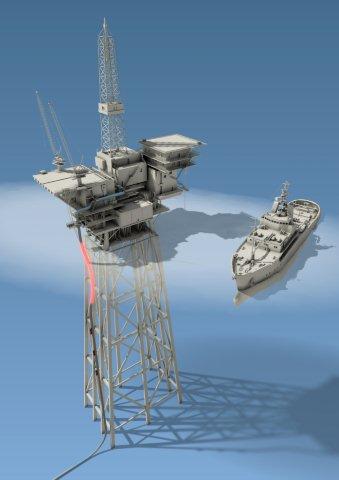December 2009 Vol. 236 No. 12
Projects
TDW's Customized Isolation Solution Smoothes Path for Safe Repair of Damaged Riser in North Sea

TDW Offshore Services AS announced Dec. 3 that it has successfully completed an innovative low pressure isolation operation on an export pipeline riser in the North Sea.
In 2007, a passing vessel collided with the southeast face of a satellite platform jacket, damaging the 12-inch export riser. Production from the platform was immediately shut in via the emergency shutdown valves, leaving the pressure in the pipeline at approximately 4 barg.
A First: Monitoring Pressure During a Low Pressure Isolation
Before production could resume, the operator needed to repair the riser. The objective was to cut and remove the damaged riser section, and replace it with a new one. To facilitate the repair process, TDW Offshore Services was retained to formulate a low pressure isolation solution in order to isolate the damaged section of the pipeline riser from the export pipeline gas inventory. The goal was to replace the damaged riser section and associated topside pipework production system safely and efficiently.
Following intensive analysis, engineering and testing, TDW developed a solution using its range of specialist pipeline pigging, pig tracking and remote communications technology. The unique approach involved using multiple high friction pigs in order to seal off and replace the damaged riser section and pipework. The solution consisted of the following elements:
- A custom-designed TDW pig trap and pigging spread.
- A high friction pig train furnished with the SmartTrack™ remote tracking and pressure-monitoring system.
- A SmartTrack subsea remote tracking and pressure-monitoring system.
- A SmartTrack topside tracking and monitoring system with radio link to the dive support vessel.
- A pipeline isolation ball valve.
During August 2009, TDW used its remote-controlled SmartTrack technology to successfully isolate the damaged riser section from the gas inventory in the export pipeline without venting or flooding the pipeline, or displacing the pipeline inventory. A three-module high friction pig train created an isolation against the gas pressure in the pipeline. The first step was to verify and record the pipeline inventory gas pressure, and close and isolate the Emergency Shut Down Valve (ESDV) 050. The redundant topside pipework located upstream of the ESDV was removed, and a temporary spool and 12-inch valve were installed upstream of the ESDV. Leakage over the ESDV was monitored closely, with a view to minimizing pressure build-up in the spool.
“Through Pipe Wall” Communications Technology Plays Key Role
Using the pig trap and pigging pump, the high friction isolation pig train (HFIPT) was launched and pigged with water to the pre-determined isolation position within as straight spool section of the vertical riser. Using TDW’s remote tracking technology, technicians onboard the dive support vessel (DSV) tracked the position of each pig to verify that the HFIPT was located below the damaged section of riser that was designated for replacement. Communication skids were positioned over the three pigs and connected to the pig monitoring system.


By doing so, TDW was able to monitor the downstream pressure of each isolation pig continuously throughout the operation using its innovative “through pipe wall” communications technology that makes it possible to send isolation integrity data by radio link to a dive support vessel.
The existing topside pipework was removed and replaced with new pipework. Divers were deployed from the DSV. The section was successfully cut and removed using a crane onboard the DSV. A mechanical connector was locked onto the existing riser. The new riser was attached to a crane on the platform and lowered down to rope access workers who installed it on the topside pipework closing spool and to the existing riser located above the HFIPT.
Following installation of the new riser section, TDW verified that the ESDV and new 12-inch valve were operating properly and fully open. After purging the riser and topside pipework, TDW used its pigging pump to slowly increase the water pressure to begin pigging the HFIPT downstream away from the platform to the launcher. The ESDV and 12-inch valve were then closed, and the pipeline gas inventory pressure was increased to keep the HFIPT moving forward. After all pigs were recovered in the temporary pig trap, the ESDV and new valve were closed. Using the platform crane and remotely-operated vehicle ROV, all pigging equipment was removed and the TDW crew demobilized. All offshore operations were carried out in about 10 weeks, from May 20 – August 2, 2009.
By using its remote tracking and pressure monitoring technology, TDW made it possible for repairs to the damaged riser to be made while maintaining a continuous flow throughout the duration of the operation. “Not only did TDW isolate the affected riser section effectively and efficiently, the innovative solution meant that the operator experienced reduced downtime,” said Rune Haddeland, General Manager of TDW Offshore Services. “The fact that this was achieved in an environmentally safe manner, in keeping with our high level of environmental standards makes it all the more impressive,” he added.
A Milestone for TDW Offshore Services
For TDW, this low pressure isolation operation represents a milestone in terms of delivery and innovation. Globally, this operator is one of TDW’s primary customers in terms of using its high pressure pipeline isolation services, both onshore and offshore. The recent operation was the first time that TDW has monitored pressure during a low pressure pipeline riser isolation operation for this valued customer.





Comments